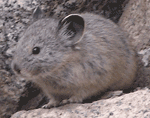 The pika (Ochotona princeps), a cousin of the rabbit may look like a hamster, but it isn't. It sometimes is known as "whistling hare" because when it dives into its burrow, it emits a high-pitched warning cry. Donald Grayson reports in the current issue of the Journal of Biogeograph that 7 out of 25 historically described American Pika populations in the Great Basin -- the area between the Sierra Nevada and Rocky Mountains, have become extinct at the end of the 20th century. Reasons described are the grazing of livestock and the increase of roads. According to Grayson, the pika populations are totally isolated from each other so they cannot reach other populations. Pikas are also considered to be one of the best early warning systems for detecting global warming.
The pika (Ochotona princeps), a cousin of the rabbit may look like a hamster, but it isn't. It sometimes is known as "whistling hare" because when it dives into its burrow, it emits a high-pitched warning cry. Donald Grayson reports in the current issue of the Journal of Biogeograph that 7 out of 25 historically described American Pika populations in the Great Basin -- the area between the Sierra Nevada and Rocky Mountains, have become extinct at the end of the 20th century. Reasons described are the grazing of livestock and the increase of roads. According to Grayson, the pika populations are totally isolated from each other so they cannot reach other populations. Pikas are also considered to be one of the best early warning systems for detecting global warming. CNN article on the extinction of the American Pika
NatureWorks on the American Pika
Keywords: diurnal
The American pika is listed as Least Concern (LR/lc), lowest risk. Does not qualify for a more at risk category. Widespread and abundant taxa are included in this category, on the IUCN Red List of Threatened Species
Some facts about the
North American pika
Adult weight : 0.1 kg (0.22 lbs)
Maximum longevity : 7 years
Female maturity :347 days
Gestation : 30 days
Weaning : 28 days
Litter size : 3
Litters per year : 2
Interval between litters : 30 days
Weight at birth : 0.009 kg (0.0198 lbs)
Weight at weaning : 0.081 kg (0.1782 lbs)
Basal metabolic rate : 1 W
Body mass : 0.109 kg (0.2398 lbs)
Temperature : 39.85 °C (103.73 °F)

Custom Search